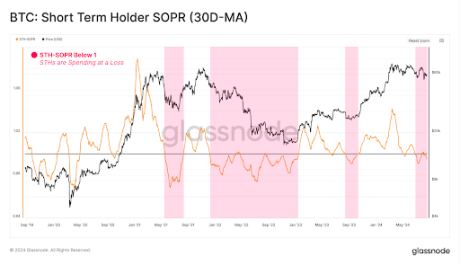Bitcoin plunged below $50,000 on August 5 in a sudden dip that liquidated many positions in the crypto market. This sudden dip, which spread to other cryptocurrencies, took the market by surprise. As such, Bitcoin fell to its lowest price in six months, and many other altcoins followed suit. Although Bitcoin has since been restored by 20% and is now commercially available around just under $60,000, many short-term investors are still dealing with unrealized losses.
A recent one report from Glassnode, a leading blockchain analytics company, sheds light on the contributing factors abrupt market decline. The report suggests that the crash was largely caused by an overreaction by short-term investors, who quickly liquidated their positions despite the initial decline.
Short-term Bitcoin holders are quickly capitulating
Short-term holders are typically defined as investors who hold their cryptocurrency assets for a relatively short period of time, often around a month or so. As such, they are prone to capitulating during periods of price corrections. This trend has been especially evident in Bitcoin’s latest price correction/consolidation, which has lasted much longer than many investors expected.
Related reading
According to Glassnode’s latest on-chain report, a key metric known as the STH-MVRV (Market Value to Realized Value) ratio has fallen below its critical equilibrium value of 1.0. When the STH-MVRV ratio falls below 1.0, it suggests that new investors are, on average, holding their Bitcoin at a loss rather than a profit. These unrealized losses, often called paper losses, occur when the market value of an asset is lower than the price at which it was acquired, but the asset has not yet been sold. This is different from realized losses, which arise from completed trades.

While periods of short, unrealized losses are common during bull markets, they tend to put selling pressure on Bitcoin’s price. This is because sustained periods of STH-MVRV trading below 1.0 often lead to a greater likelihood of panic and capitulation among short-term holders. This phenomenon notably contributed to the Bitcoin crash earlier this month.
Related reading
Furthermore, Glassnode’s report reveals this correlation and selling pressure may already be taking placewhere the STH-SOPR (Spent Output Profit Ratio) is also below 1.0. The STH-SOPR ratio measures the profitability of output spent and indicates whether assets are sold at a profit or loss. What this essentially means is that many short-term investors are taking more realized losses than gains. This follows claims that many short-term investors have overreacted to the price corrections.

While short-term holders have worn most of it of the losses during the recent recession, long-term holders remain strong. At the time of writing, Bitcoin is trading at $59,540 and is down 2.15% in the last 24 hours.
Featured image created with Dall.E, chart from Tradingview.com

